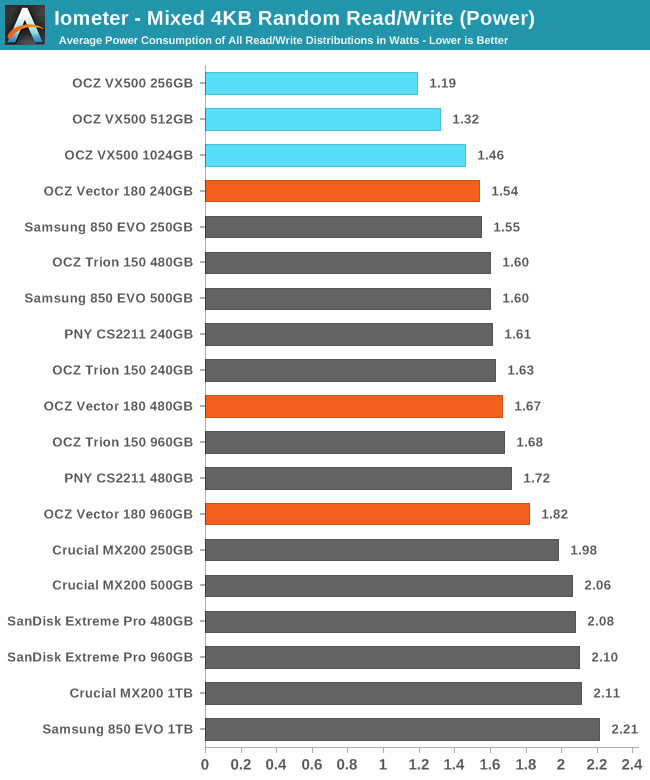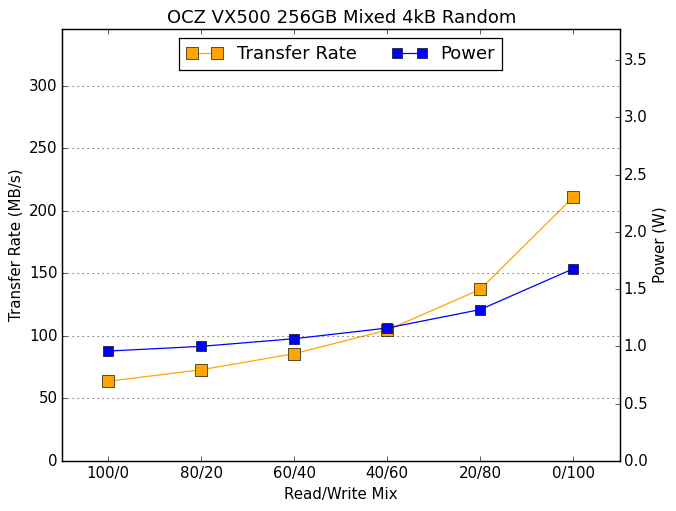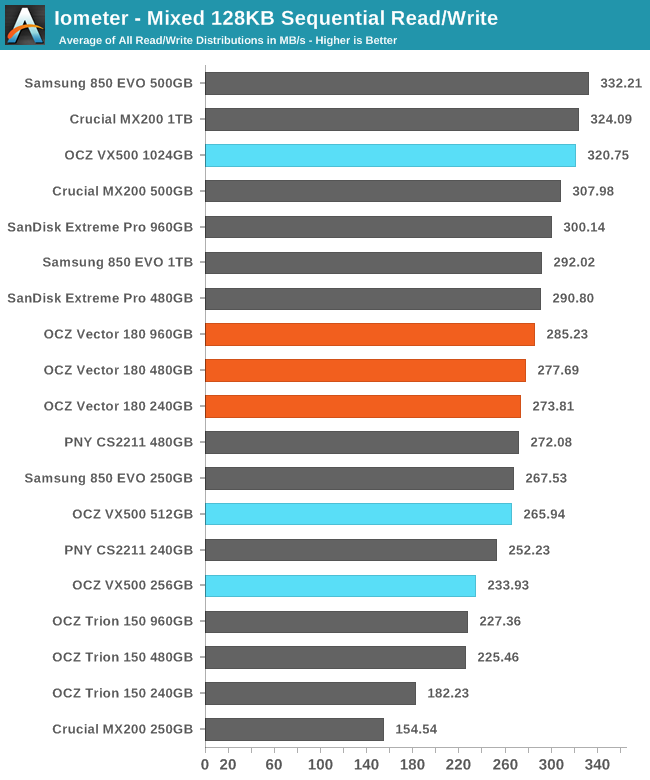The Toshiba OCZ VX500 (256GB, 512GB, 1024GB) SSD Review
by Billy Tallis on September 13, 2016 9:00 AM ESTMixed Random Read/Write Performance
The mixed random I/O benchmark starts with a pure read test and gradually increases the proportion of writes, finishing with pure writes. The queue depth is 3 for the entire test and each subtest lasts for 3 minutes, for a total test duration of 18 minutes. As with the pure random write test, this test is restricted to a 16GB span of the drive, which is empty save for the 16GB test file.

The OCZ VX500 delivers slightly better mixed random I/O performance than the Vector 180, but both are still about average for mainstream drives and significantly behind the top performers.

As usual, the VX500 uses very little power and thus has great efficiency, competitive with the much higher-performing Samsung 850 EVOs.
 |
|||||||||
The VX500 starts out at a bit of a disadvantage with a low random read speed, but it never drops in performance as more writes are added to the mix. It does not benefit from the significant spike in performance some drives achieve once the workload shifts to pure writes.
Mixed Sequential Read/Write Performance
The mixed sequential access test covers the entire span of the drive and uses a queue depth of one. It starts with a pure read test and gradually increases the proportion of writes, finishing with pure writes. Each subtest lasts for 3 minutes, for a total test duration of 18 minutes. The drive is filled before the test starts.

The 1TB OCZ VX500 lands near the top of the chart on this test, but the smaller two capacities are slightly slower than the Vector 180 they are replacing.

Power consumption is good, but only the 256GB VX500 uses significantly less than any of the competition. Efficiency is still very good for all three capacities and competitive with the best drives with planar or 3D NAND.
 |
|||||||||
Once again, due to the drive being filled before the test the smaller two VX500s do not handle the write-heavy portions of the test well. The 1TB model is able to deliver peak write performance during parts of the test, allowing its average transfer rate to recover some in the second half.










29 Comments
View All Comments
Chaitanya - Tuesday, September 13, 2016 - link
How is the after sales service of these drives since Toshiba take over? I have heard some horror stories of RMA with OCZ in past.JebSpringfield - Tuesday, September 13, 2016 - link
I bought one OCZ drive a year after Toshiba took over. The SSD failed after one month, and they replaced it with a better model (I had to pay for the shipping), after another month or so, the new drive also failed. I contacted them again but this time I said I was not going to pay for shipping. They agreed, and sent me their top of the line model which has 5 year warranty and it's been working fine (knock on wood) for a bit longer than a year.Sorry but I don't remember the models.
Meegul - Tuesday, September 13, 2016 - link
While that doesn't speak to the quality of the drives, at least the customer service stepped up. The old OCZ days were just fraught with stories about the customer service affectively being MIA.StevoLincolnite - Tuesday, September 13, 2016 - link
...I'm still running a 64Gb OCZ Vertex 2 from 6-7 years ago... I WANT IT TO DIE SO I CAN UPGRADE.gammaray - Wednesday, September 14, 2016 - link
both my ocz vertex III and Agility III are still running fine lol. Meanwhile i bought an assorted battery of other SSDs, Main rig running Sandisk Extreme Pro.creed3020 - Wednesday, September 14, 2016 - link
Likewise! I have that same drive as my boot drive for my HTPC. Its definitely slower than it once was but thankfully it keeps on chugging. My next gen HTPC will include a newer, bigger boot drive. Not sure what will happen to the SATA II drive when I rebuild...Bullwinkle J Moose - Monday, October 3, 2016 - link
A Vertex 2 is Super Easy to KillJust follow OCZ recommendations on upgrading the firmware
(NO, I am NOT joking)
B.T.W.,
Anandtech really needs to update their testing procedure for SSD's
The original Vertex could copy and paste a 2GB file (to and from the same drive) at a blistering rate of 3.6 - 3.7 MB/sec
A Samsung 840 Pro can copy/paste the same file at 56.8 MB/sec
A Samsung 850 Pro can copy/paste the same file at 113.7 MB/sec
YES, AN 850 PRO IS TWICE AS FAST AS AN 840 PRO!
Disclaimer:
ALL tests made with XP-SP2 on SATA2 Ports using IDE protocol
Your results will vary depending on O.S. / Port Type and Protocol
Hardware and O.S. were kept identical to that used when testing the Vertex 1 & 2 which are no longer available for testing on newer hardware
ocztaec - Thursday, September 15, 2016 - link
Hi JebSpringfield,As this is my first post on this article please allow me to identify myself as a Toshiba America Electronic Components (TAEC) representative. Thank you for your comment and great to hear the current replacement drive is working well for you. We greatly appreciate both your business and support.
fanofanand - Wednesday, September 14, 2016 - link
I won't be taking the risk. They refused to honor their warranty when my OCZ DDR2 sticks failed. Lifetime warranty my azz.....ocztaec - Thursday, September 15, 2016 - link
Hi fanofanand,Thank you for your comment and your business. I'm sorry to hear that you had issues in the past. We understand how you feel and hope that one day we will have the opportunity to demonstrate the reliability of our current Toshiba products. Thanks again for your feedback.